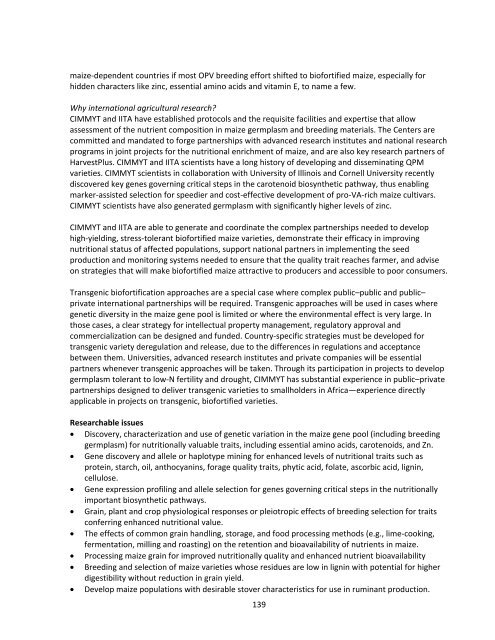Download - Maize
Download - Maize
Download - Maize
Create successful ePaper yourself
Turn your PDF publications into a flip-book with our unique Google optimized e-Paper software.
maize‐dependent countries if most OPV breeding effort shifted to biofortified maize, especially for<br />
hidden characters like zinc, essential amino acids and vitamin E, to name a few.<br />
Why international agricultural research?<br />
CIMMYT and IITA have established protocols and the requisite facilities and expertise that allow<br />
assessment of the nutrient composition in maize germplasm and breeding materials. The Centers are<br />
committed and mandated to forge partnerships with advanced research institutes and national research<br />
programs in joint projects for the nutritional enrichment of maize, and are also key research partners of<br />
HarvestPlus. CIMMYT and IITA scientists have a long history of developing and disseminating QPM<br />
varieties. CIMMYT scientists in collaboration with University of Illinois and Cornell University recently<br />
discovered key genes governing critical steps in the carotenoid biosynthetic pathway, thus enabling<br />
marker‐assisted selection for speedier and cost‐effective development of pro‐VA‐rich maize cultivars.<br />
CIMMYT scientists have also generated germplasm with significantly higher levels of zinc.<br />
CIMMYT and IITA are able to generate and coordinate the complex partnerships needed to develop<br />
high‐yielding, stress‐tolerant biofortified maize varieties, demonstrate their efficacy in improving<br />
nutritional status of affected populations, support national partners in implementing the seed<br />
production and monitoring systems needed to ensure that the quality trait reaches farmer, and advise<br />
on strategies that will make biofortified maize attractive to producers and accessible to poor consumers.<br />
Transgenic biofortification approaches are a special case where complex public–public and public–<br />
private international partnerships will be required. Transgenic approaches will be used in cases where<br />
genetic diversity in the maize gene pool is limited or where the environmental effect is very large. In<br />
those cases, a clear strategy for intellectual property management, regulatory approval and<br />
commercialization can be designed and funded. Country‐specific strategies must be developed for<br />
transgenic variety deregulation and release, due to the differences in regulations and acceptance<br />
between them. Universities, advanced research institutes and private companies will be essential<br />
partners whenever transgenic approaches will be taken. Through its participation in projects to develop<br />
germplasm tolerant to low‐N fertility and drought, CIMMYT has substantial experience in public–private<br />
partnerships designed to deliver transgenic varieties to smallholders in Africa—experience directly<br />
applicable in projects on transgenic, biofortified varieties.<br />
Researchable issues<br />
Discovery, characterization and use of genetic variation in the maize gene pool (including breeding<br />
germplasm) for nutritionally valuable traits, including essential amino acids, carotenoids, and Zn.<br />
Gene discovery and allele or haplotype mining for enhanced levels of nutritional traits such as<br />
protein, starch, oil, anthocyanins, forage quality traits, phytic acid, folate, ascorbic acid, lignin,<br />
cellulose.<br />
Gene expression profiling and allele selection for genes governing critical steps in the nutritionally<br />
important biosynthetic pathways.<br />
Grain, plant and crop physiological responses or pleiotropic effects of breeding selection for traits<br />
conferring enhanced nutritional value.<br />
The effects of common grain handling, storage, and food processing methods (e.g., lime‐cooking,<br />
fermentation, milling and roasting) on the retention and bioavailability of nutrients in maize.<br />
Processing maize grain for improved nutritionally quality and enhanced nutrient bioavailability<br />
Breeding and selection of maize varieties whose residues are low in lignin with potential for higher<br />
digestibility without reduction in grain yield.<br />
Develop maize populations with desirable stover characteristics for use in ruminant production.<br />
139

















